What About Radio-Carbon Dating?
(c) Copyright 2000, David A. Duncan
Science vs. Biblical History
Christians are often confronted with scientific data in which fossils are "dated" by scientific methods and determined to be 30,000 to 50,000 years old. In general, conservative Christians believe that the age of the earth is the range of 6,000 to 10,000 years old. These dates are often given by trying to determine the age of the earth by using the Bible as a history book. Probably the most famous of these dating attempts is that of Bishop Ussher and is sometimes listed in the margins of Bibles indicating that creation occurred in 4004 B.C.
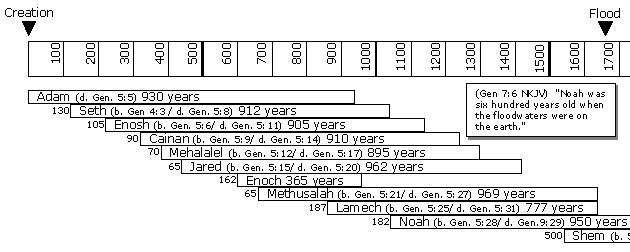
Adding up the given dates shown above in the chart then according to the biblical account the flood occurred about 1656 years after creation. Similarly, the date given for the time of Joseph is about 2259 years[1] after the creation. The time of Joseph (according to our accounting of years) is not certain. The time of Joseph is often correlated with the Egyptian pharaohs reigning during his time and often placed during the time of the Hyksos dynasty.[2] While there is some uncertainty in some of the dates (primarily in dating Joseph), the conclusion is that according to Bible history, the earth is in the range of 6,000 to 10,000 years old with many conservative scholars arguing for the early date.
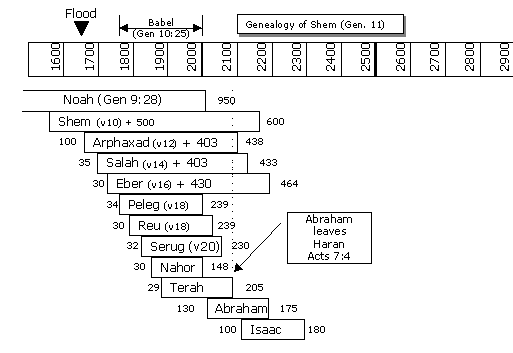
This places Christian beliefs at odds with dates given for fossils that are older than 10,000 years old. If the Bible is true, then the dates must be wrong. Conversely, if the dates are correct, then the Bible is proven to be false in its timeline.
Why 10,000 instead of 6,000
From the times given in Genesis chapters 5 & 11, many argue for a literal 6,000 years for the age of the earth as shown in the timelines above. Some acknowledge that the times given especially in chapter 11 leave some room for extra time that is not accounted for. Morris & Whitcomb, in their book "The Genesis Flood", argue for the possibility of additional time than that specified in Genesis 11 on the basis of the follows reasons.
Some names may have been left out
It was common practice for the Jews to omit names when giving a genealogy. For instance, the genealogy in Matthew has three lists of 14 names (Abraham to David, David to Jeconiah, Jeconiah to Jesus), with the lists likely trimmed to aid in memorization. For example, Matthew 1:8 has "… and Joram begot Uzziah." However, it is known from 2 Chronicles, chapters 21-26, that three generations were skipped in this statement of Matthew (2 Chronicles has Jehorm, Ahaziah, Joash, Amaziah, Uzziah). This illustrates the ancestral usage of the term "begat", which can mean to be the ancestor of (i.e. Joram, or Jehoram, was the "ancestor of" Uzziah). It is possible then that names have been left out in Genesis 11, as Luke has Cainan between Salah and Arphaxad (Luke 3:35-36 NKJV: "… the son of Shelah, (36) the son of Cainan, the son of Arphaxad, …"). The symmetry of Genesis, chapters 5 and 11, is similar to that of Matthew. In both chapters 5 & 11, there is a list of 10 names, with the last name having three important sons.
The fathers beyond the River were Idolatrous
According to the strict-chronology shown in the chart above, when Abraham was called to leave Haran at his father’s death, four of the fathers who were born before the tower of Babel incident, would still have been alive. Joshua said that Abraham’s fathers who dwelt on the other side of the River were idolatrous (Joshua 24:2,15). This would seem unlikely while Shem, who was on the Ark, was still alive.
World Divided in Peleg’s Day
According to Genesis 11, an interesting thing about the life-spans is that it is beginning with Peleg that life-spans shorten significantly. This is a permanent drop of about 45%. Up to Eber, the shortest life-span is 433 years (Salah), but beginning with Peleg, life-spans never exceed the 239 years of Peleg. The general chart of life-spans that is shown to illustrate the life-spans before and after the flood shows an exponential decay of life-spans after the flood. Closer examination of the data shows that there is likely at least one more exponential decrease centered around the lifetime of Peleg and possibly another during the lifetime of Abraham so that during the life-time of Moses the life-span was observed to be 70 years (Ps. 90:10) as shown below:
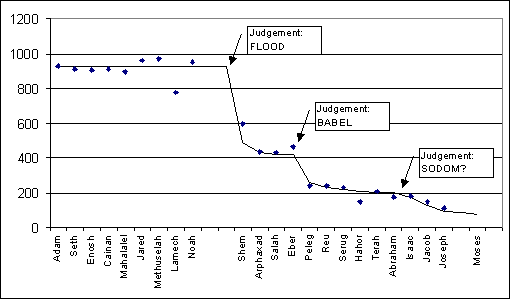
It is generally conceded that the statement of Genesis 10:25 ((Gen 10:25 NKJV) "To Eber were born two sons: the name of one was Peleg, for in his days the earth was divided; …") refers to the judgment of Babel. It seems strange that the writer would mention that the world was divided in the days of Peleg, if as shown above all of the Post-deluvian fathers (and Shem as well) were still alive.
Nations Were Ancient in Abraham’s Day
"The Bible implies that the world of Abram’s day, with its civilizations and cities, was ancient already; and we are left with the unmistakable impression that its peoples had long since been divided ‘after their families, after their tongues, in their lands, in their nations’ (Gen. 10:5, 20, 31)."[3] According to Genesis, the land of Canaan was populated with the descendants of those who had left Babel -- (Gen 15:18-21 NKJV). On the same day the LORD made a covenant with Abram, saying: "To your descendants I have given this land, from the river of Egypt to the great river, the River Euphrates; {19} "the Kenites, the Kenezzites, the Kadmonites, {20} "the Hittites, the Perizzites, the Rephaim, {21} "the Amorites, the Canaanites, the Girgashites, and the Jebusites." The Amorites are already fallen into iniquity (Gen 15:16). According to the strict-chronology, it was at this time only about 200 years since Babel (if we assume the middle portion on Peleg’s lifetime).
Messianic Links Not Necessarily First-Born Sons
There is no clear indication that all of the links in Genesis 11 are first-born sons. The account of Abraham provides some insight into the methodology of the genealogical listings. The statement of Genesis 11:26 says (NKJV) "Now Terah lived seventy years, and begot Abram, Nahor, and Haran. It is likely that these three were not triplets, and even though Abram is listed first, it is apparent from other scriptures that he is not the firstborn. Acts 7:4 has Abraham not leaving Haran until after Terah is dead, and Genesis 12:4 has Abraham leaving Haran at the age of 75 (see chart below):
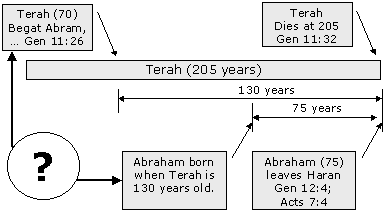
The conclusion of Gen. 12:4 and Acts 7:4 is that Abraham was born when Terah was about 130 years old. The statement of Gen. 11:26 then is stating the age at which Terah began to have children with the children listed in order of prominence rather than birth sequence. If this same methodology is utilized for the other genealogies in Genesis 11, it is impossible to put together an accurate timeline since we have no indication whether the messianic link is a first-born son or not. With the pattern being the time given when the man begins to have children ("the beginning of strength", (Deu 21:17 KJV "… for he is the beginning of his strength; the right of the firstborn is his.", see also Gen. 49:3), then unless the child is a first-born son, we can not know the number of years between the "beginning of strength" and the time the specified child is born. This alone can add a period of about 700 years to the timeline.
Use of Ancestral Begat
As has been noted, the term "begat" can be used in the sense that a child is an ancestor of the one doing the begetting (as has been shown earlier in Matthew 1:8 where "Joram begat Uzziah", but three generations are omitted). The case of Amram and Jochebed is particularly important. In Exodus 6:20 it is stated "And Amram took him Jochebed his father's sister to wife; and she bare him Aaron and Moses: and the years of the life of Amram were an hundred and thirty and seven years." This sequence is similar to that of Genesis 11 in that it records the begattal, and the number of years of the man’s life. It is significant that when Numbers 3:17-19, 27-28 is examined, the descendants of Amram’s father (i.e. Amram and 3 brothers) number 8,600 males. Now, if the number of men and women were each about 50%, then in two generations (i.e. that of Amram, Izhar, Hebron, Uzziel, and their children) over 17,000 children are produced!
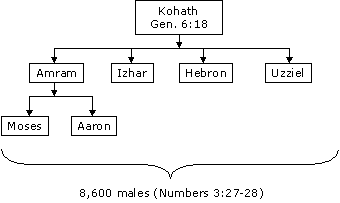
Whitcomb and Morris conclude: "Unless we are willing to grant that the first cousins of Moses and Aaron had over 8,500 living male offspring, we must admit that Amram was an ancestor of Moses and Aaron, separated from them by a span of 300 years!"[4] Further: "we feel justified in assuming that Peleg was a distant descendant of Eber. Now the objection might be raised at this point that Genesis 10:25 cannot allow for such a view; for in that passage we read that ‘unto Eber were born two sons: the name of the one was Peleg; for in his days was the earth divided; and his brother’s name was Joktan.’ How, then, could Peleg be a distant descendant of Eber, if we are told in this passage that Eber had two sons of whom one was Peleg? Would not such a statement preclude the possibility of a merely ancestral relationship? Indeed, this would be a serious objection, were it not for our parallel case in Exodus 6:20. There we found that two sons were born unto Amram. But from the third chapter of Numbers we also discovered that Moses and Aaron were only two of 8,600 living descendants of Amram’s father. Now the very same thing could be true of Genesis 10:25, where we read that two sons were born unto Eber. By analogy with Exodus 6:20, then it seems quite possible that Peleg and Joktan were only two of the many living descendants of Eber at the time of God’s judgment upon Babel."[5]
Conclusion
Now, in the manner shown above of trying to let the biblical genealogy methodology comment on the text of Genesis 11, many feel that some additional time can be accounted for in the biblical account. The possibility that names have been omitted from the record, and the ancestral usage of "begat" allowing for multiple generations to be omitted, leave room for as much as 4,000 years of time to be added to the age of the earth (bringing the total from 6,000 to 10,000). Some argue that if this is the case, then why not millions? Whitcomb and Morris respond: "But the analogy of Biblical chronology, the obvious proximity of the judgment of Babel to the Flood, and the problem of Reu, Serug, and Nahor make it highly improbable that such an extended post‑deluvian chronology can be allowed. This improbability approaches impossibility when we consider the oral traditions of the Flood which have been incorporated into such documents as the Gilgamesh Epic of Babylonia."[6]
While we have documented times where up to 300 years may be skipped over in genealogy listings. This is quite different from hundreds of thousands of years (or millions) being skipped.
Carbon-14 Dating
The most reliable dating tool that scientists have (apart from archaeological evidence) is Carbon‑14 dating (also known as Radiocarbon Dating). This technique was developed in the late 1940's by Willard F. Libby, an American chemist. C14 is a radioactive isotope of Carbon (C12) that is naturally produced in the atmosphere by solar radiation.
|
|
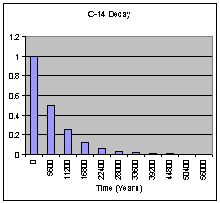 While an organism is living it takes in
radioactive carbon in the form of carbon dioxide and there is a fairly constant
ratio of C14 to C12.
When the organism dies, the radioactive carbon begins to decay. The ratio of C14 to C12 can then be used to determine
when the organism died. It can be seen from the graph that the useful range of
dates for Carbon-14 dating is only about 50,000 to 60,000 years.
While an organism is living it takes in
radioactive carbon in the form of carbon dioxide and there is a fairly constant
ratio of C14 to C12.
When the organism dies, the radioactive carbon begins to decay. The ratio of C14 to C12 can then be used to determine
when the organism died. It can be seen from the graph that the useful range of
dates for Carbon-14 dating is only about 50,000 to 60,000 years.
There are some inherent assumptions in the Carbon-14 dating process: (1) the level of C14 production by solar radiation is a constant, and (2) the sample has not been contaminated by outside influences.
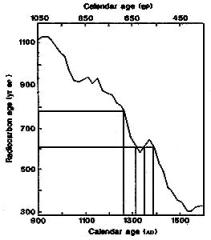 The first assumption is known to be
wrong. Radiocarbon dating is usually
calibrated by using tree-ring data to compensate for the effect of varying
levels of C14 production (as shown in the chart[7]). This allows the range of dates back to about
1600B.C. to be fairly certain. Beyond
that, the calibration is unknown.
Estimates beyond this assume a uniformitarian concept -- i.e. the
processes going on during that time are the same processes going on now. The variation in the past 3000 years is not
proof of the processes going on 10s of thousands of years in the past. Many scientists believe in catastrophic
events in the past such as an meteorite collision that changed the environment
so much that all of the dinosaurs died.
The first assumption is known to be
wrong. Radiocarbon dating is usually
calibrated by using tree-ring data to compensate for the effect of varying
levels of C14 production (as shown in the chart[7]). This allows the range of dates back to about
1600B.C. to be fairly certain. Beyond
that, the calibration is unknown.
Estimates beyond this assume a uniformitarian concept -- i.e. the
processes going on during that time are the same processes going on now. The variation in the past 3000 years is not
proof of the processes going on 10s of thousands of years in the past. Many scientists believe in catastrophic
events in the past such as an meteorite collision that changed the environment
so much that all of the dinosaurs died.
A Changing Environment
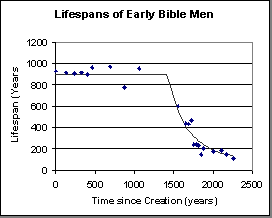
According to the biblical timeline, the lifespan of man was significantly shortened starting around the time of the flood. Noah's flood was a global event undoubtedly accompanied by a catastrophic change in the environment. This agrees with many evidences which indicate a catastrophic change in the earth such as seashells found on the tops of mountains, and frozen mammoths found in extremely cold climates such as Siberia, but having plants in their mouths and stomachs which are temperate in nature.[8] The evidence for a catastrophic change renders C14 dates older than 4000 years to be more speculation than science, and as a minimum cannot be verified with any certainty.
One of the changes in the earth's environment is the steadily decreasing magnetic field. Scientists are not in agreement here, but there is evidence that the earth's magnetic field is exponentially decreasing. "It is an accepted fact that the measurements of the Earth's magnetic field strength show that the field is rapidly growing weaker. Professor Thomas G. Barnes, who has studied the earth's magnetic field, says that the magnetic field is declining in strength exponentially. Prof. Barnes, who has developed the earlier work of Horace Lamb, demonstrates mathematically that the observed exponential decline in the strength of the earth's magnetic field is exactly what one would expect if the earth's magnetic field is generated by an enormous electric current flowing in the earth's iron core. The decline is due to a continuous loss of electrical energy caused by electrical resistance in the core."[9]
"Direct measurements of the earth's magnetic field over the past 140 years show a steady and rapid decline in its strength."[10] "If this type of decline has been occurring in the past, the field loses half of its strength every 1400 years. Scientific research suggests that an increase in the earth's magnetic field to 100 times its present strength would result in complete shielding from cosmic radiation. As a crude approximation, … [with] a 1% decrease in C14 formation for each doubling of the current field strength in the calculations of radiocarbon dates … the effect of the magnetic field increase does not become large until times earlier than Noah's Flood."[11]
"Although it was hailed as the answer to the prehistorian's prayer when it was first announced, there has been increasing disillusion with the [radiocarbon] method because of the chronological uncertainties—in some cases absurdities—that would follow a strict adherence to published C-14 dates ... What bids to become a classic example of `C-14 irresponsibility' is the 6,000 year spread of 11 determinations for Jarmo, a prehistoric village in northeastern Iraq which, on the basis of all archeological evidence, was not occupied for more than 500 consecutive years."—*C.A. Reed, "Animal Domestication in the Prehistoric Near East," in Science, 130 (1959), p. 1630. [12]
"Well authenticated dates are known only back as far as about 1600 B.C. in Egyptian history, according to John G. Read [*J.G. Read, Journal of Near Eastern Studies, Vol, 29, No. 1, 1970]. Thus, the meaning of dates by C-14 prior to 1600 B.C. is still as yet controversial."—H.M. Morris, W.W. Boardman, and R.F. Koontz, Science and Creation (1971), p. 85. [13]
"The first shock Dr. Arnold and I had was that our advisors informed us that history extended back only 5,000 years . . You read books and find statements that such and such a society or archaeological site is [said to be] 20,000 years old. We learned rather abruptly that these numbers, these ancient ages, are not known; in fact, it is about the time of the first dynasty in Egypt that the last [earliest] historical date of any real certainty has been established."—*W.F. Libby, "Radiocarbon Dating," in American Scientist, January 1956, p. 107. [Libby was the one who pioneered the discovery of Carbon 14 dating.] [14]
Contamination
One of the biggest problems with Carbon-14 dating is contamination of the samples. It is exceedingly difficult to be certain that the sample has not been affected when the item has been submerged in mud or water. A small contamination combined with lower levels of Carbon-14 can significantly affect the results.
"Local variation, especially in [marine] shells, can be highly significant ... The most significant problem is that of biological alteration of materials in the soil. This effect grows more serious with age. To produce an error of 50 percent in the age of a 10,000 year old specimen would require the replacement of more than 25 percent of the carbon atoms. For a 40,000 year old sample, the figure is only 5 percent, while an error of 50,000 years can be produced by about 1 percent of modern material. Much more must be done on chemical purification of samples."—*F. Johnson, *J.R. Arnold, and *R.F. Flint, "Radiocarbon Dating," in Science, February 8, 1957, p. 240. [15]
"Some geologists question the use of the C-14 method for samples stored under moist conditions. This is a most serious limitation, for who can be sure that a given sample has not been moistened?"—E.A. von Fange, "Time Upside Down," in Creation Research Society Quarterly, June 1974, p. 17. [16]
When contamination has occurred, it leads to some interesting results:
"A mastodon skeleton, found at Ferguson Farm near Tupperville, Ontario, provided a radiocarbon age of 8,900 for the collagen fraction of bones and a radiocarbon age of 6,200 for high organic-content mud from within the skull cavities. It is unlikely that this skeleton could have survived exposure for 2,700 solar years before emplacement in peat."—Robert H. Brown, "Radiocarbon Age Measurements Re-examined," in Review and Herald, October 28, 1971, pp. 7-8.
Accuracy of the C14 Measurement
C14 measurements have become more accurate in recent years with newer techniques. "In one method of radiocarbon dating, scientists burn a piece of the object and convert it to carbon dioxide gas. The carbon dioxide is purified, and the amount of radiocarbon in the purified carbon dioxide is measured with radiation counters. These instruments detect the electrons released by the radiocarbon atoms as the atoms change back into nitrogen atoms. The number of electrons emitted indicates the radiocarbon content."[17]
A newer technique called "Accelerator Mass Spectrometry" (AMS) uses particle accelerators, requires a much smaller sample, and is much more accurate. "The first object ever to be probed by the radioactive decay of carbon 14 was a precious specimen of acacia wood excavated from a ceiling beam of the tomb of Zoser, deep in the interior of the Step Pyramid at Saqqara, Egypt. This sample, measured in 1947, gave a reading six hundred years too young for the alleged date based on astronomical chronology and king-lists."[18] According to Ryan and Pitman, Glenn Jones of the Woods Hole Oceanographic Institution dated another sample of this same wood, but this time using AMS only a toothpick sized sample was needed. "His new age, calibrated by tree rings that chart the temporal variations of carbon 14 production in the atmosphere, was completely consistent with the archaeological estimate ‑ right down to the century. One could do no better since it was impossible to know how long in advance of the pharaoh's death the tree had been harvested."[19]
Christian Acceptance of C14 Dates
While Christians contest the older dates obtained using C14 dating, not all of the dates are contested. Where there is ample evidence of C14 production using tree-ring data, accurate measurements using AMS techniques, and evidence that the sample has not been contaminated, the C14 method is very accurate and useful to Christian evidences.
For example, the evidence for the date of the Dead Sea Scrolls (including the Isaiah scroll which is strong evidence for the accurate transmission of the O.T. text) has been verified using C14 dating techniques.
"Researchers in the Arizona Accelerator Mass Spectrometer (AMS) Laboratory at the University of Arizona have carbon-14 dated samples of the Dead Sea Scrolls, and their results are consistent with ages determined by paleographic research. A. J. Timothy Jull, Research Scientist, and Douglas J. Donahue, Physics Professor and Director of the AMS facility, measured the amount of radioactive carbon in samples of 18 texts and two textiles from four Qumran Caves and from Nahal Hever, both in the Dead Sea region. Carbon-14 dating of milligram samples taken from ragged edges of manuscript margins determined the ages of the scrolls to range from the third century B.C.E. (Before Common Era) to 68 C.E., nearly 2,000 years ago. These dates support earlier paleographic research, which estimated the ages of the scrolls by analyzing the handwriting styles, materials, and formatting of the manuscripts."[20]
Shroud of Turin
These two scientists (A. J. Timothy Jull, and Douglas J. Donahue) also participated in a paper published in "Nature" magazine reporting on the dating of the Shroud.
The conclusion: "Very small samples from the Shroud of Turin have been dated by accelerator mass spectrometry in laboratories at Arizona, Oxford and Zurich. As Controls, three samples whose ages had been determined independently were also dated. The results provide conclusive evidence that the linen of the Shroud of Turin is medieval. … The age of the shroud is obtained as AD 1260-1390, with at least 95% confidence."[21]
Other Radio-Dating Techniques
C14 dating is the most accurate dating method, mostly because some of the dates can be verified and calibrated using tree-ring data. Scientists who take a uniformitarian approach (and therefore argue for a very old earth), advocate a need for dating techniques which have a useful span of millions to billions of years. Since C14 is only good for about 50,000 years, other methods have been used including: rubidium-strontium, Thorium-Lead, Potassium-Argon, and Potassium-Calcium.
"Archaeologists use potassium-argon dating to find the age of certain rock formations in which archaeological objects are discovered. These rocks contain radioactive potassium 40, which changes into argon 40 gas at a constant rate. Scientists measure the amount of each element present and then calculate the age of the rock."[22]
Each of these has problems, with vast disagreements when the different methods are used with the same sample. "Lunar soil collected by Apollo 11 gave discordant ages by different methods: Pb207 / Pb206, 4.67 billion; Pb206 / U238, 5.41 billion; Pb207 / U238, 5.41 billion; Pb207 / U235, 4.89 billion; and Pb208 / Th232, 8.2 billion years. Rocks from the same location yielded K / Ar ages of around 2.3 billion years."—R.E. Kofahl and K.L. Segraves, Creation Explanation (1975), pp. 200, 201. [23]
These all suffer from the same problems which plague C14 dating -- including the inability to establish initial conditions and the inability to establish a lack of contamination.
"Most igneous rocks also contain uranium in a form that is readily soluble in weak acids. Hurley (1950) found that as much as 90 percent of the total radioactive elements of some granites could be removed by leaching the granulated rock in weak acid."—*M.R. Klepper and *D.G. Wyant, "Notes on the Geology of Uranium," in U.S. Geological Survey Bulletin 1046-F, 1957, p. 93. [24]
"As much as 80 percent of the potassium in a small sample of an iron meteorite can be removed by distilled water in 4.5 hours."—*L.A. Rancitelli and D.E. Fisher, "Potassium-Argon Ages of Iron Meteorites," in Planetary Science Abstracts, 48th Annual Meeting of the American Geophysical Union (1967), p. 167. [25]
"Why do the radioactive ages of lava beds laid down within a few weeks of each other differ by millions of years?"—Glenn R. Morton, "Electromagnetism and the Appearance of Age," in Creation Research Society Quarterly, March 1982, p. 229. [26]
"Other methods, e.g., uranium-lead and thorium-lead ages, have resulted in contradictory evidence. A classic example is that the dust samples on the moon seem to be older than the rocks underneath."—Erech von Fange, "Time Upside Down," in Creation Research Society Quarterly, June 1974, p. 17. [27]
Apparent Age
While the ages that scientists produce seem to conflict tremendously with the Bible account for C14 obtained dates of living things, it should be recognized that these dates are based on assumptions which cannot be proven. The much older dates given by other methods for dating rocks, can only, at best, measure "apparent age." On the day in which Adam was created, an observer who could only look at appearances might judge Adam to be 18 years old. The observer might be correct if he stated that Adam "appeared" to be 18 years old. The earth also may have an "apparent age" which does not match its actual age. In these cases, the Bible and science should not be forced into contradiction, but rather it should be acknowledged that there is no need to try to make them agree. It is obvious that if the creation account of the earth is to be believed, then the Universe must have had an apparent age. From measurements, we know that some stars are many "light-years" away from us, but the account in Genesis 1 has the stars ruling over the night. A scientific observer would observe an "apparent age" based solely on the observation of light from the stars having had to travel "light-years" to reach the surface.